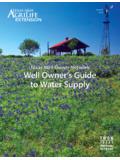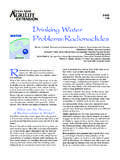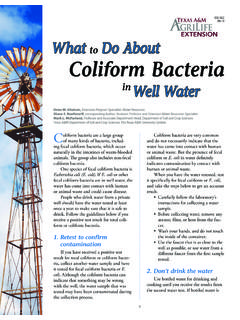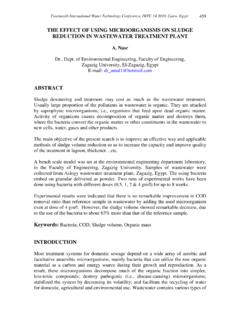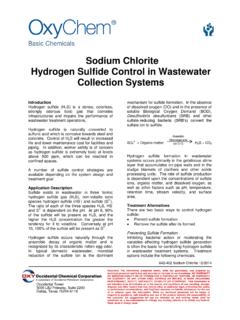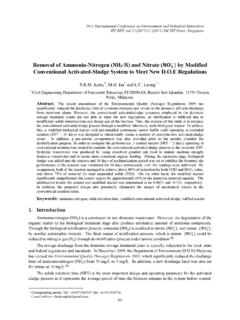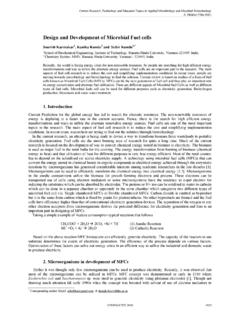Transcription of Maintain Your Septic System - TWON
1 E S C- 0150 9 -14 Maintain your Septic SystemtotoProtect Well WaterRyan A. Gerlich, Extension Program SpecialistKristine A. Uhlman, Extension Program Specialist Water ResourcesDiane E. Boellstor , Corresponding Author; Assistant Professor and Extension Water Resources Specialist Mark L. McFarland, Professor and Associate Department Head, Department of Soil and Crop SciencesAnish R. Jantrania, Associate Professor and Extension SpecialistJohn W. Smith, Extension Program SpecialistThe Texas A&M University System1If your home or business uses an onsite wastewater treatment System , commonly known as a Septic System , you need to know how to operate and Maintain it properly.
2 Otherwise, sewage could back up into your house, enter surface water such as rivers and lakes, or contaminate your water well. About 25 percent of the homes being built in the United States have onsite wastewater treatment systems. To keep from polluting the environment and posing health hazards to people, the property owners must Maintain their Septic systems regularly. e underground water that supplies wells and springs is called groundwater. It is the source of drinking water for many Texans. Millions of gallons of groundwater may be located under a typical home site, farm, or ranch. Groundwater can become contam-inated by materials seeping down from Septic systems, fuel tanks, livestock pens, and fertilizer and pesticide storage areas.
3 E decisions you make about maintaining your property can signi cantly a ect your family s health and your drinking water. ey can also a ect your property values and your legal liability. Consider the questions in Table 1. If you answer yes or don t know the answer to any question, you may have a high-risk situation on your property. Information on how to address each question follows. How Septic systems work To understand how to operate and Maintain your onsite wastewater treatment System , it helps to know how it works and what factors a ect it. Information on the design and operation of di erent types of systems is available on the website of the Texas A&M AgriLife Extension Service Bookstore at You may also consult the manufacturer s literature for your speci c System .
4 E most common onsite wastewa-ter treatment System is the conventional 2septic System (Fig. 1). is System consists of a Septic tank and a soil absorption eld, which is also called a drain eld. When wastewater leaves a home or business, it goes rst to the Septic tank, an enclosed watertight container where the solids are separated from liquid wastes. ere, microorganisms (also called microbes) begin consuming the nutrients and organic matter in the the partially treated wastewater (also called e uent) moves to the drain eld. e e uent travels through perforated pipes to a bed of gravel or other similar material, where microbes consume more of the waste.
5 Finally, the e uent moves into the soil where it will evaporate, be used by plants, or drain deeper into the soil and potentially into wastewater treatment systems come in many types and sizes. e operation and maintenance requirements of your System depend on: e treatment method used to remove contami-nants from the wastewater e amount of wastewater that the System must handle e strength of the wastewater , which is the amount of contaminants it contains. Waste- water contains solids, nutrients, organic matter, and pathogens (disease-causing microorgan-isms). Table 1. Questions to help owners determine whether their Septic systems are not functioning NO QUESTIONS 1.
6 Is your Septic tank less than 50 feet from a water well? 2. Have you noticed wet or smelly areas in your yard? 3. Has it been more than 3 to 5 years since the Septic tank was pumped? 4. Is your Septic tank too small to accommodate the number of people living in your home? 5. Do you dispose of chemicals, fats, or trash down the drain? 6. Do you use moisturizers, conditioners, or chemical cleaning materials, or is back-flush water from a water softener discharged to the Septic System ? 7. Have you built structures or do you drive vehicles or heavy equipment over the Septic System ? 8. Are you concerned about water conservation?
7 Soil absorption fieldTwo-compartmentseptic tankPerforated pipefor effluent disposalSand/loam soilGravelGeotextile fabricFigure 1. Conventional onsite wastewater treatment System . 31. Is your Septic tank less than 50 feet from a water well?To reduce the risk of contamination, onsite waste-water treatment systems must be located away from vulnerable water sources and other environmental fea-tures. e amount of separation is called the setback distance. Table 2 lists some of the setback distances required for Septic systems in Texas. For more information on setback distances, see the AgriLife Extension Service publication Onsite wastewater Treatment Systems: Selecting and Permitting (available at ).
8 2. Have you noticed wet or smelly areas in your yard?If your System is not maintained properly, it will malfunction (Fig. 2). Follow the maintenance instruc-tions for the equipment installed for your System . A poorly designed, constructed, or maintained System can fail and return contaminated water to the surface of your property and to lakes, streams, and well water. 3. Has it been more than 3 to 5 years since your Septic tank was pumped? Bacteria cannot completely break down all the sol-ids in the tank. Over time, scum and sludge will build up and reduce the amount of solids that the tank can hold. If enough accumulate, solids will be discharged into the drain eld, and it will become clogged or 2.
9 Minimum required separation distances (in feet) from specific site features to the soil absorption field or spray System . Separation distance (feet)Feature Soil absorption field Spray Tank Private water well100100 50 Private water well (pressure cemented or grouted to 100 ft or cemented or grouted to the water table if it is less than 100 ft deep)505050 Streams, ponds, lakes, rivers (as measured from normal pool elevation water level).
10 Salt water (high tide only)75 Reduced to 50 if using an advanced system5050 Foundations, buildings, surface improvements, property lines easements, swimming pools, and other structures5 None, except 10 ft* from property lines and 25 ft from swimming pools5 Public water well15015050 Public water supply line101010*A separation distance of 10 feet is required for spray systems controlled by a timer. A separation distance of 20 feet is required for uncontrolled spray systems, which spray effluent whenever the pump tank is 2. Surfacing e uent around a failing Septic tank. Excessive vegetation, foul odors, stained soils, and saturated ground can indicate that the Septic System is Follow these steps to help the microbes in the Septic tank treat the wastewater properly: Have the Septic tank pumped when the com-bined depths of the scum layer and sludge layer reach one-fourth to one-third of the total tank volume.
